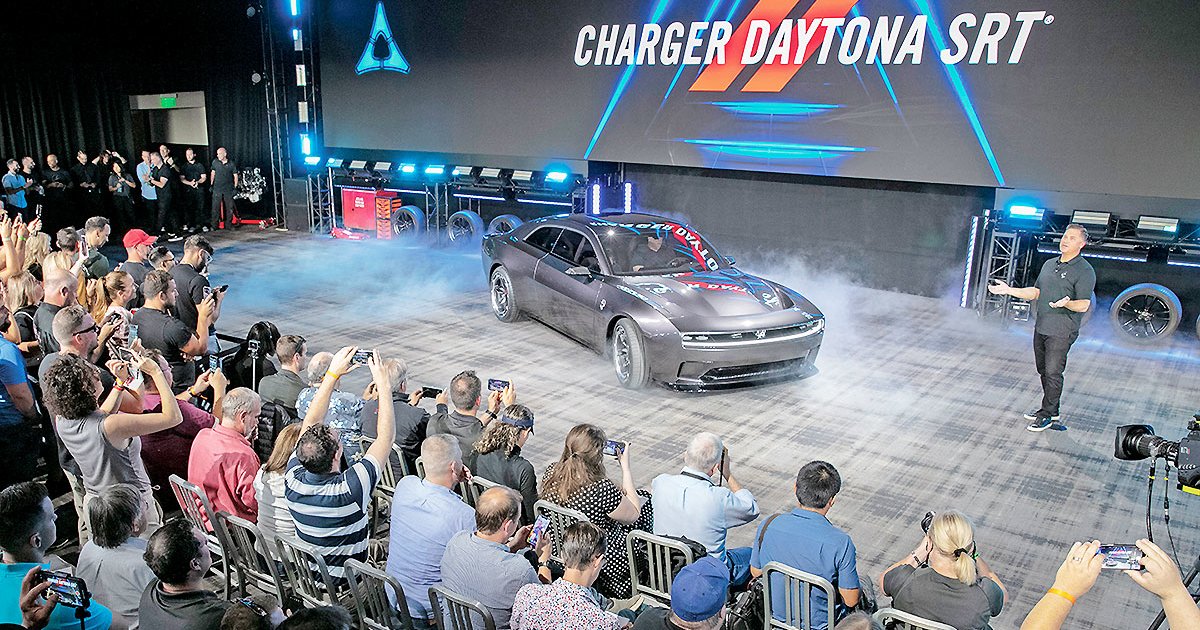
DETROIT — Dodge couldn’t quietly join the electric-vehicle party, it had to crash it and make some noise in the process.
The brand, known for a brash attitude and roaring engines, is making clear it won’t water down that audacity in the battery-power era. In contrast to the parade of near-silent EVs introduced in recent years, the Charger Daytona SRT, an electric muscle car concept Dodge showed last week, is just as loud and fast as today’s 700-plus-hp Hellcats.
“Dodge is going to get lost if we’re trying to do the same thing as everybody else, so let’s go, let’s invent, let’s create, let’s do something different than [what] anybody else out there is doing,” Dodge CEO Tim Kuniskis said. “Let’s show them that electrification can still shock people.”
Kuniskis said the brand needed to do an EV the “Dodge way” with patents, innovations and performance that would “reverberate through the entire industry.” Engineers inventing the future of Dodge, he said, developed an EV “that you didn’t see coming, but you’ll definitely hear it coming.”
The Daytona SRT has an industry-first EV simulated exhaust system that produces up to 126 decibels through an amplifier and tuning chamber at the rear. At a media event to unveil it, a booming voiceover asserted that even though Dodge is going electric, the brand still intended “to remain loud” and “to be irrational.”
Dodge’s first electric car is due in 2024, after the gasoline-powered Challenger and Charger go out of production next year.
Names that have long defined Dodge muscle such as Hemi, Hellcat and Redeye will give way to a new kind of performance, called Banshee. The 800-volt Banshee propulsion system, Dodge says, makes the Charger Daytona EV surpass a Hellcat in all key performance measures.
Randy Dye, chairman of the Stellantis National Dealer Council, said he thought the concept’s sound was “insane” when he first heard it.
Dye said Dodge has a clearly established identity that many consumers like, and he’s glad it isn’t straying from that as it moves into electrification. Dye, who owns Daytona Dodge-Chrysler-Jeep-Ram in Florida, believes Dodge made a statement with the concept’s design: EVs don’t have to be “generic” or “ugly.”
“Electric vehicles can be beautiful,” Dye said. “They can look powerful and they are going to be powerful, so I think it’s just another way to do power.”
Jessica Caldwell, executive director of insights for Edmunds, said Dodge is figuring out how it can stand out and find a niche in an EV market that will grow significantly over the next decade.
Caldwell said the Charger EV concept and the Hornet plug-in hybrid that Dodge also revealed last week appear closely aligned with the brand’s history even with new technologies.
“It feels very true to Dodge heritage and what they have been for so many years,” Caldwell said. “I think from at least a branding standpoint, it’s not different. It’s just Dodge is who they are, but now they’re going to have EVs and PHEVs.”
Dodge, which is on pace to sell only one-third as many vehicles in the U.S. this year compared with a decade ago after shrinking its lineup, isn’t shooting for specific volume targets as it transitions to EVs, Kuniskis said. He insisted he’s more focused on profit margins and building up the brand.
The concept’s Banshee fender badging, Kuniskis said, is essentially a mishmash of the Hellcat and Demon logos. For now, the Hellcat will remain a symbol of gasoline-powered muscle. Dodge decided to adopt a new name for its approach to EVs.
“We wanted to call it something fresh and something new, but yet we needed to call it something because one of the cornerstones of the brand is the attachment, and the attachment comes out of a name,” Kuniskis said in an interview. “It’s hard to get attachment if you don’t have a name.”
Dodge has made its mark as a brand selling high performance for the masses. The Scat Pack variants of the Charger and Challenger, which start around $50,000, have resided in what Kuniskis describes as the heart of the muscle car market.
Kuniskis wouldn’t discuss pricing for the upcoming EVs but said he knows where the sweet spot is and that Dodge needs to be there.
“If I can make a real boxy-looking muscle car, and I put a huge battery in it, I’m never going to be able to sell it because nobody can afford it,” Kuniskis said. “But if I make it slippery and still cool, I don’t have to have as big of a battery, I can still have the great range and my price goes down dramatically.”